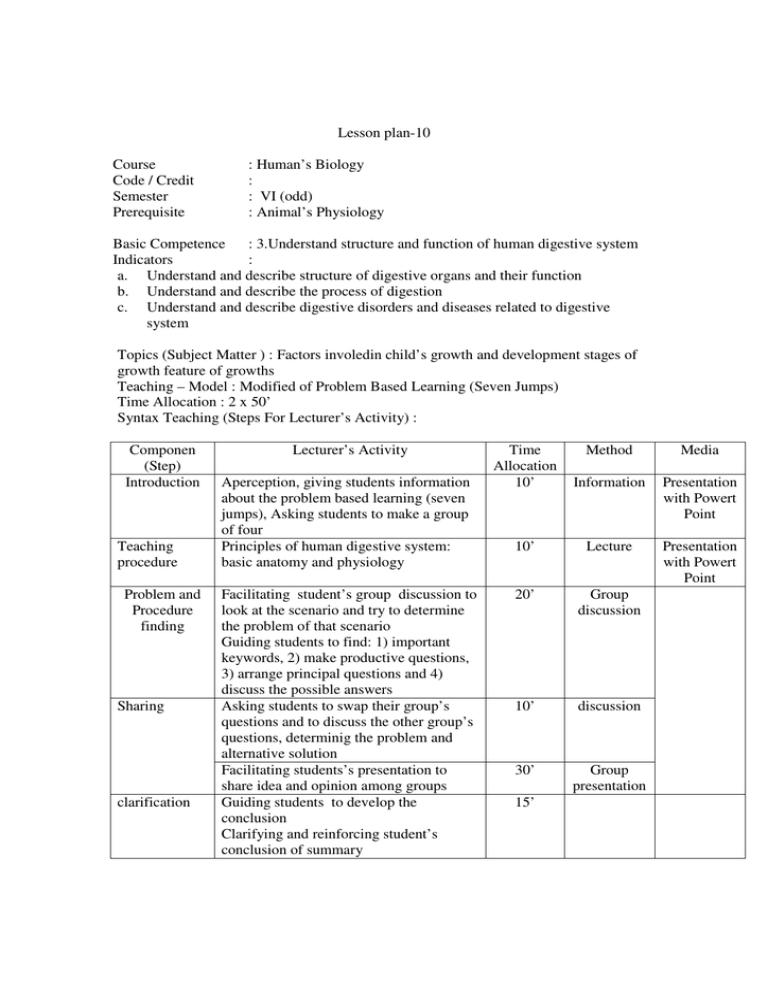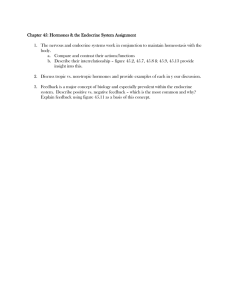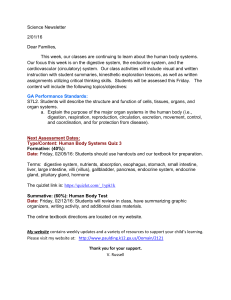Lesson plan-10 Course : Human’s Biology
advertisement

Lesson plan-10 Course Code / Credit Semester Prerequisite : Human’s Biology : : VI (odd) : Animal’s Physiology Basic Competence : 3.Understand structure and function of human digestive system Indicators : a. Understand and describe structure of digestive organs and their function b. Understand and describe the process of digestion c. Understand and describe digestive disorders and diseases related to digestive system Topics (Subject Matter ) : Factors involedin child’s growth and development stages of growth feature of growths Teaching – Model : Modified of Problem Based Learning (Seven Jumps) Time Allocation : 2 x 50’ Syntax Teaching (Steps For Lecturer’s Activity) : Componen (Step) Introduction Teaching procedure Problem and Procedure finding Sharing clarification Lecturer’s Activity Aperception, giving students information about the problem based learning (seven jumps), Asking students to make a group of four Principles of human digestive system: basic anatomy and physiology Facilitating student’s group discussion to look at the scenario and try to determine the problem of that scenario Guiding students to find: 1) important keywords, 2) make productive questions, 3) arrange principal questions and 4) discuss the possible answers Asking students to swap their group’s questions and to discuss the other group’s questions, determinig the problem and alternative solution Facilitating students’s presentation to share idea and opinion among groups Guiding students to develop the conclusion Clarifying and reinforcing student’s conclusion of summary Time Allocation 10’ Method Media Information Presentation with Powert Point 10’ Lecture Presentation with Powert Point 20’ Group discussion 10’ discussion 30’ Group presentation 15’ Follow Up Giving students a task to study the literature 5’ Assignment STUDENT’S WORKSHEET (10) Topics : anatomy and physiology of stomach Objective : 1. To describe basic structure of stomach 2. To define enzymes and hormones secreted by the stomach and their function 3. To describe any disorders related to stomach Activity : 1. Draw a picture of human stomach (gaster) 2. Draw the histological view of stomach, define the cells and their secretion 3. Draw the concept of gastritis, ulcer and cancer based on your picture Lesson plan-22 Course Code / Credit Semester Prerequisite : Human’s Biology : : VI (odd) : Animal’s Physiology Basic Competence : 3.Understand structure and function of human endocrine system Indicators : a. Understand and describe the concept of homestasis, homeostatic regulation b. Understand and describe positive and negative feedback c. Understand and define “endocrine” d. Understand and describe hormones and their action mechanism e. Define and describe main endocrine glands, their secretion and function f. Give examples of some disorders (disease) related to endocrine system Topics (Subject Matter ) : Human Endocrine System Teaching – Model : Lecture and Discussion Time Allocation : 2 x 50’ Syntax Teaching (Steps For Lecturer’s Activity) : Componen (Step) Introduction Teaching procedure Sharing clarification Follow Up Lecturer’s Activity Aperception, giving students some issues related to endocrine disorders Giving examplechild’s growth develelopment Definition of endocrine and hormones Concept of homeostatis, feedback Hypothalamus hypophyseal axis Thyroid and parathyroid gland Pancreas Adrenal gland Other hormone-secreted organ Facilitating students’s to share idea and opinion Guiding students to develop the conclusion Clarifying and reinforcing student’s conclusion of summary Giving students a task to collect other issues of endocrine from mass media Time Allocation 10’ Method Media Information Presentation with Powert Point 50’ Lecture 20’ discussion 10’ discussion 10’ Assingment STUDENT’S WORKSHEET (22) Topics : endocrine glands Objective : 1. To define endocrine glands 2. To describe structure function of endocrine glands 3. To mention diseases related to the endocrine glands Activity : 1. Make three small groups consisting of 4 students 2. Discuss the picture below 3. Define the structure shown by number from 1 to 8 4. Describe their basic structure and their function 5. Mention the diseases related to the structures









